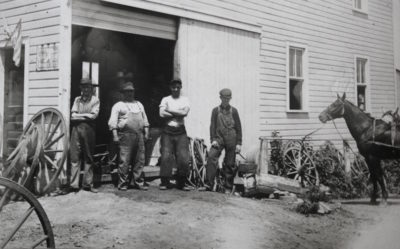
Al Klindt, second from the right wearing a white T-shirt with his arms folded, stands outside his blacksmith shop in Long Grove. Klindt’s shop was located across the street from Stockman’s Savings Bank when two men robbed it on Dec. 15, 1921. He and other citizens of Long Grove participated in a gun battle that mortally wounded the robbers. Photos courtesy of City of Long Grove, Iowa
By John Brassard Jr.
Harry Hamilton, who suffered for two days in a Davenport hospital in December 1921 before succumbing to gunshot wounds he received while robbing a bank in Long Grove, lived life on the edge. He had come west to Davenport, was married and had several jobs, including becoming a police officer for a few months in 1918. After that, he went to work as an editor for the Rock Island News, owned by the notorious Rock Island gangster John Looney.
Known for making slanderous accusations against people that Looney didn’t like, the publication of such statements in the Rock Island News eventually led to Hamilton’s arrest for criminal libel. However, he was able to turn state’s evidence against the managing editor of the newspaper in return for a lighter sentence.
After his short prison term, Hamilton was freed, but soon ran afoul of the law, robbing eastern Iowa businesses as part of a gang. He was sent to state prison for his part in a robbery in Wheatland in early 1920, but was released in the fall of 1921.
He seemed to mean well this time, telling several people that he wanted to get his act together, to put his life of crime behind him. But no one would give him a job during the recession. So, Hamilton decided to rob a bank.
Roy Purple, who was also gunned down on that fateful day in December 1921 and was Hamilton’s partner in crime, was a 31-year-old barber in Davenport. He had been married to his wife, Edith, for four years and they had twin sons who were about a year old. Purple, his wife noted, began hanging out with the “wrong crowd” and had been previously detained and questioned by Davenport police about another robbery. They didn’t have enough evidence to convict him, so they let him go.
At some point — nobody knows how or when — Hamilton met Purple and the two men began planning their first (and last) bank robbery together in early December 1921.
They chose Stockman’s Savings Bank in Long Grove, a small farming community of about 150 people located 11 miles north of Davenport, as their target.
During the first week of December 1921, Hamilton cashed a $20 bill at Stockman’s Savings Bank to see the building’s layout. He and Purple stashed a change of clothes in a ditch south of Long Grove, spending several hours by the roadside on the pretense of changing a tire on a car they procured for the heist from a repair shop in Davenport. Then on the morning of Dec. 15, 1921, they left Davenport for Long Grove to rob the bank.
TO READ MORE ABOUT THIS STORY AND OTHER FASCINATING STORIES ABOUT IOWA HISTORY, subscribe to Iowa History Journal. You can also purchase back issues at the store.
